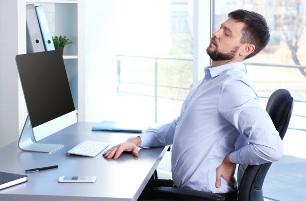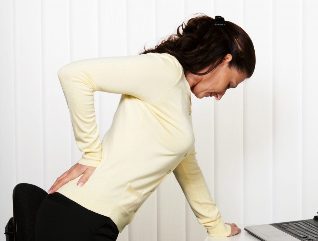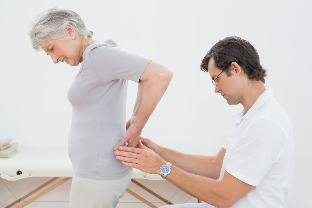
Acute pain in the lumbar region, on the background of degenerative disc disease of the spine – a widespread problem faced by the vast majority of people. After we got "awards" for our bipedalism (due to the increase of the axial load on the spine), the disease formerly helena later hits for everyone on the planet, the problem is only in how quickly it's happening, and how they are expressed in symptoms. Such a "bleak" statistics of the forcing to know this pathology to socially significant diseases, and the fight with her should be the task not only of the individual person suffering from the manifestations of the disease, but also the global health care system in general. So the question of the treatment of degenerative disc disease of the spine – the theme is very current.
So what is osteochondrosis? Let's see briefly how the development of the disease. In itself its name, if you translate it from Latin, literally, defined the structure, changing in osteochondrosis: bone and cartilage. With the aim of cushioning and resistance to vertical load nature has between our bones eccentric fibro-cartilage "cushions" — the intervertebral discs. Their nutrition is carried out in childhood through the blood vessels, which lost approximately 25 years, and the food begins to be diffuse at the expense of the surrounding muscles.
During pathological loading on the spine (sedentary work, or on the contrary – the excessive physical burden), violations of the processes of mineral exchange of the intervertebral disc loses its elastic and damping properties, decreases its height, it changes the structure of the vertebrae, appear abnormal bone growths (osteophytes and zamechatelnye boards), impaired mobility of the affected spine. In the later stages of disease the central portion of the intervertebral disc, the so-called gelatinous core, breaking the fibrous ring, form a peculiar saccular protrusion between bodies of vertebrae — intervertebral hernia. A hernia can cause compression of the with adjacent to the vertebrae the nerve roots, leads to intense pain in the area of compression, and also in the field, adjustable work affected nerve. Because of the constant irritation of the nerve plexus arises from the reflex spasm of the skeletal muscles, in medicine known as a protective defense, on the one hand protects the suffering from separation of the spine from unnecessary movements, but on the other hand, it increases the compression, swelling and pain in the affected area.
In the majority of cases (90%) is painful when osteochondrosis (even very significant) driven by a muscle spasm! In other cases, the cause of the pain – compression of the nerve root helena of the spinal cord directly to the herniated disc.
Osteochondrosis of the lumbar spine: how to treat
Of all the divisions of the spine, and the total per person is five (cervical, thoracic, lumbar, sciatic and coccygeal), because of what the largest motor load most of the manifestations of the disease are suffering from lumbar. Osteochondrosis of the lumbar spine is located, become familiar with all the symptoms and treatment this is an important social task, because it deteriorates the quality of life for not only older, but also active people in the working age population.

The pain can be localized directly in the lumbar region, as well as on the front side of the thigh, helena across the back of helena the outer surface of the leg, sometimes into the fingers. Often the pain of giving away the gluteal guests of the sacrum, the groin, and sometimes can be localized only in these areas, masking under the diseases of sexual sphere and of the intestines and prevents the setting of a correct diagnosis. The intensity of the pain syndrome can be so high that a person loses the ability to perform the most basic movements, taking forced possession of your body and lose the normal sleep. Is it the same nerve, which in broad circles long since become synonymous with the disease itself.
Limitation of physical activity. Disturbed by the usual movements and tenderness in the limbs, arise muscle cramps, paresthesia (sensations of tingling, burning, "crawling fever").
Violation of the functions of the organs of the pelvis. During intense radicular syndrome, known to all as sciatica, helena in a massive Grajewo the protrusion may even be broken urination and bowel, causing severe pain in the patient.
Treatment of degenerative disc disease of the lumbar spine often becomes a daunting task both for the patient and the doctor. Every person suffering from this disease has been preoccupied with questions of: "How to treat osteochondrosis of the lumbar?", "Than to treat degenerative disc disease of the lumbar?", "If treatment is degenerative disc disease of the lumbar at home does not help – to what doctor to go?", "If tablets and ointment in the lumbar osteochondrosis help - how to treat?".
To cope with deterioration of degenerative disc disease and to appoint a competent treatment for you to the following physicians: therapist, neurologist, specialist in medical massage, manual therapist, physiotherapist, and if necessary, surgical treatment – a doctor, a neurosurgeon.
Ways to deal with osteochondrosis of the lumbar spine
The main thing in the treatment of degenerative disc disease – the right lifestyle! In humans, actively and properly engaged in physical education and are looking for the backbone, your back will never hurt! Unfortunately, the few who adheres to these simple truths.
Deconstructing this question, one can distinguish:
- treatment;
- a non-drug.
Without the pharmacological treatment of the pathology in the lumbar spine
Intrusive procedures. Their effect lies in the title - the application of different applicators, massage mats and paint rollers, wool belt, "lotions" and "rastirok" due to the impact on the surface of nerve endings and blood vessels somewhat reduces muscle cramps and pain syndrome. These methods can be used as an auxiliary, but isolated their application in sharpening the degenerative disc disease of the lumbar without systemic treatment with special drugs ineffective.
Means of immobilization. Under these funds, you realize tires of different construction, fit that allows you to protect the spine from sudden and "dangerous" movements and the redistribution of the load in a static job. The means of immobilization can be purchased in stores medical facilities and pharmacies, however, before buying it is advisable to consult a doctor who will help you determine the most appropriate in your situation design, the rigidity and the fittings of the orthosis. Their use is appropriate only at the time of the action of unfavorable factors (travel, driving, sedentary work, etc.), because long-term use causes malnutrition of the muscles.
Therapeutic physical training (LTV) – be an integral part of the comprehensive treatment of degenerative disc disease. Perform exercises aimed at maintaining muscle tone carbon back muscles and the removal of the disorders: muscle cramps, help in restoring and maintaining physical activity, reduction of the intensity of the pain syndrome. A significant plus LTV in the fact that after the training, the instructor can a person a day independently perform the exercises at home, but also in the existence of a complex of exercises, applicable even when the deterioration process. The most effective way to exercise therapy is of mechanotherapy – lessons on simulators to the individually developed the methodology because they form a muscular corset is needed, is to work with weights.
Massage – known since ancient times, the most common, and it is perhaps the most popular patients the way of prevention and treatment, however, in the stage of acute degenerative disc disease of the lumbar applied cannot be. In addition, to perform massage in osteochondrosis should only the expert with medical education, excellent knowledge of anatomy and physiology, and control techniques this is the reason health, therapeutic massage.
Manual therapy and a growing popularity in recent years osteopathy in the execution of a competent professional can have a significant therapeutic effect, and even for a long time to get rid of exacerbations of the disease. It is also important to remember that when access to a manual to the physician before starting the procedure it is necessary to conduct instrumental examinations of the spine (radiography, computed helena magnetic resonance imaging, osteodensitometry), will allow doctors to evaluate the incidence and the severity of the process and rule out any possible contraindications to manipulation. How and massage, manual therapy and osteopathy have a number of contraindications, such as significant compression of a nerve root of hernia, subluxation of the vertebrae. In the acute period of degenerative disc disease of the lumbar used, as a rule, soft techniques of manual therapy (muscle relaxation, etc.).
Acupuncture. According to the results of recent studies using this popular in a wide circle method is considered to be of evidentiary medicine go nuts in osteochondrosis of the lumbar spine, is not addressing the symptoms of the disease, and refers to unconventional methods of treatment.
Physiotherapy, contained in the national clinical recommendations and standards of the provision of health care in osteochondrosis, long ago proved its effectiveness in the treatment of this disease. When osteochondrosis in the lumbar spine are applied electromyostimulation, amplipuls-therapy, shock-wave therapy, interstitial biostimulate, laser. A popular method in the complex treatment of the remains of magnetic therapy. To its benefits apply a good portability and a small list of contraindications, possibility of use in the acute period of the disease. It acts on all the aspects of an unhealthy process, it is already through several procedures significantly reduces pain and allows a person to expand the physical activity. In addition, due to the improvement of the trophic affected tissues slowing the progression of the disease. A clear advantage of this method is the possibility of its independent use by the patient outside the walls of the medical facility.
But if all of the above without pharmacological methods have proved ineffective - than then to treat lumbar osteochondrosis?
Treatment treatment
Disease suggests indications for these drug groups:
Non-steroidal anti-inflammatory drugs (NSAIDS) are produced in the forms for both local (gels, ointments, creams), so for the system apps (tablets, suppositories, solutions for intramuscular and intravenous introduction). Their action is based on blocking the inflammatory process on the enzymatic level, the result of which is excluded, swelling in the area of damage and greatly reduces the painful.
In the early stages of the disease is sufficient local application of NSAIDS in combination with non-drug methods (therapeutic gymnastics, magnet). When expressed pathological process and the intense pain syndrome resort to preformed, and sometimes even injection forms of medication.
Unfortunately, with a good anti-inflammatory and analgesic effect of NSAIDS, long-term systemic use can cause the development and worsening of ulcerative-erosive processes of the gastrointestinal tract, as well as the violation of the functions of the kidneys and liver. Therefore, the patients in the course of time taking nsaids, they are also needed drugs that protect the mucosa of the stomach and regular laboratory checks on indicators of liver and kidney function.
Systemic muscle relaxants, i.e., the drugs, the elimination of spasm. The principle of their action lies in the name: relaxation of the spasm of the muscles, helps to reduce the compression of nerves and blood vessels, swelling in the area of the lesion – improves blood circulation and innervation – reduces pain; reduction of La in the muscles reduces the tension of the ligamentous apparatus – reduces the bulging (protrusion) of the intervertebral disc – it abates the pain, increases the amount of movement.
Muscle relaxants for the treatment of degenerative disc disease of the spine is produced in the form of tablets and solution for intramuscular use, for achieving a therapeutic effect is taken to be for a long time, gradually increasing the dose. They are also non-steroidal anti-inflammatory agents, muscle relaxants have a number of contraindications and may cause adverse side effects, so despite the free sale in pharmacies networks, prior to their acquisition it is necessary to consult with your doctor.
Local anesthetics helena drugs for local anesthesia is used for medical treatment of lumbar degenerative disc disease in the form of the so-called paravertebral blockade, if stone drugs first injected subcutaneously, and then in the field of processes of the affected vertebrae in the projection of the intended compression of the nerve root.
Accumulate in the membranes of nerve fibres, the product effectively blocks the pain signal. Doctor therapist, you will surely achieve such a blockade will not be able to, for its implementation it is necessary to turn to a neurologist helena neurosurgeon.
Also for paravertebral introduction are sometimes used solutions of corticosteroids (GCS) - hormonal drugs, which have a pronounced anti-inflammatory effect. Local their use allows to achieve the maximum effect while minimizing the risk of undesirable side actions of the drug. Such a blockade of the courses are held 2-3 times per year, their implementation must physician neurologist helena doctor-neurosurgeon.
Vitamins of group "In". In each pharmacy you can find different drugs of this group, both in the forms for oral administration, for intramuscular administration. It is believed that they have a neurotrophic and easy analgesic action, but a credible rationale for their use in osteochondrosis of the spine evidentiary medicine fails.
Physical therapy in osteochondrosis of the lumbar

Unfortunately, sometimes complex treatment with the use of modern drugs, physical therapy, massage and movement therapy is proving ineffective – the man continues to feel the pain persists, physical activity limitations, significantly affects the quality of life. So it is in the late stages of the disease, when it forms large, often more gryzenia protrusion of the intervertebral discs. In such a situation is shown surgical intervention. In addition to the quick intervention is indicated when the so-called "hair loss hernia", when a significant compression of the spinal canal causing nekupirutayasa pain, static-dynamic disturbances and blockage of the function of the bladder and bowel. In such cases, surgery is performed in emergency situations right. The aim of surgical interventions in osteochondrosis of the lumbar spine is a mechanical spinal decompression canal and nerve roots.
At the present time in the surgical treatment of degenerative disc disease are used as long-known volumetric methods of operation, and which offers the modern medicine minimally invasive endoscopic intervention with the use of laser and radio frequency exposure, a part of which may take place under local anesthesia.
After considering the basic ways how to treat degenerative disc disease of the lumbar spine, I want to emphasize once again, that the patient, sets the question "how to cure lumbar degenerative disc disease?", must not only rely on the help of doctors, but also on their own strength, realizing the importance of a healthy lifestyle, which is welcome proper nutrition, it uses the right dosage of the physical load, and what is the most important, is the present belief in victory over the disease.
































